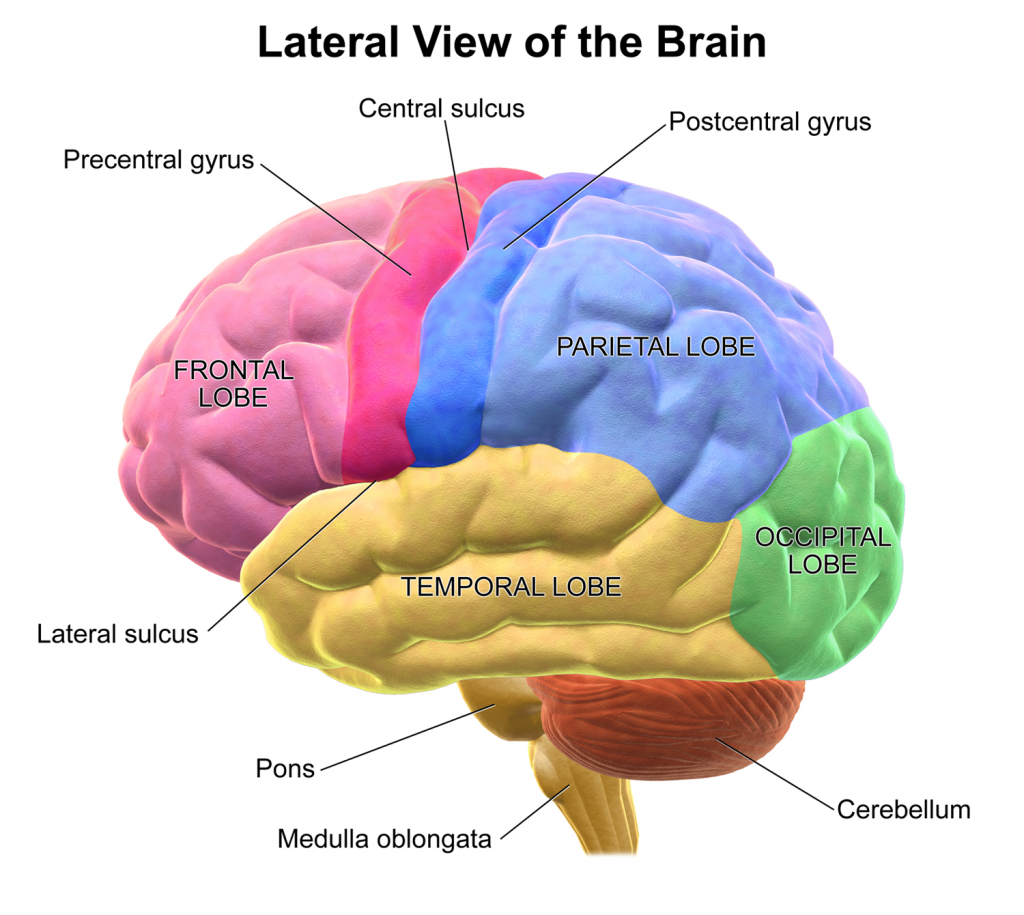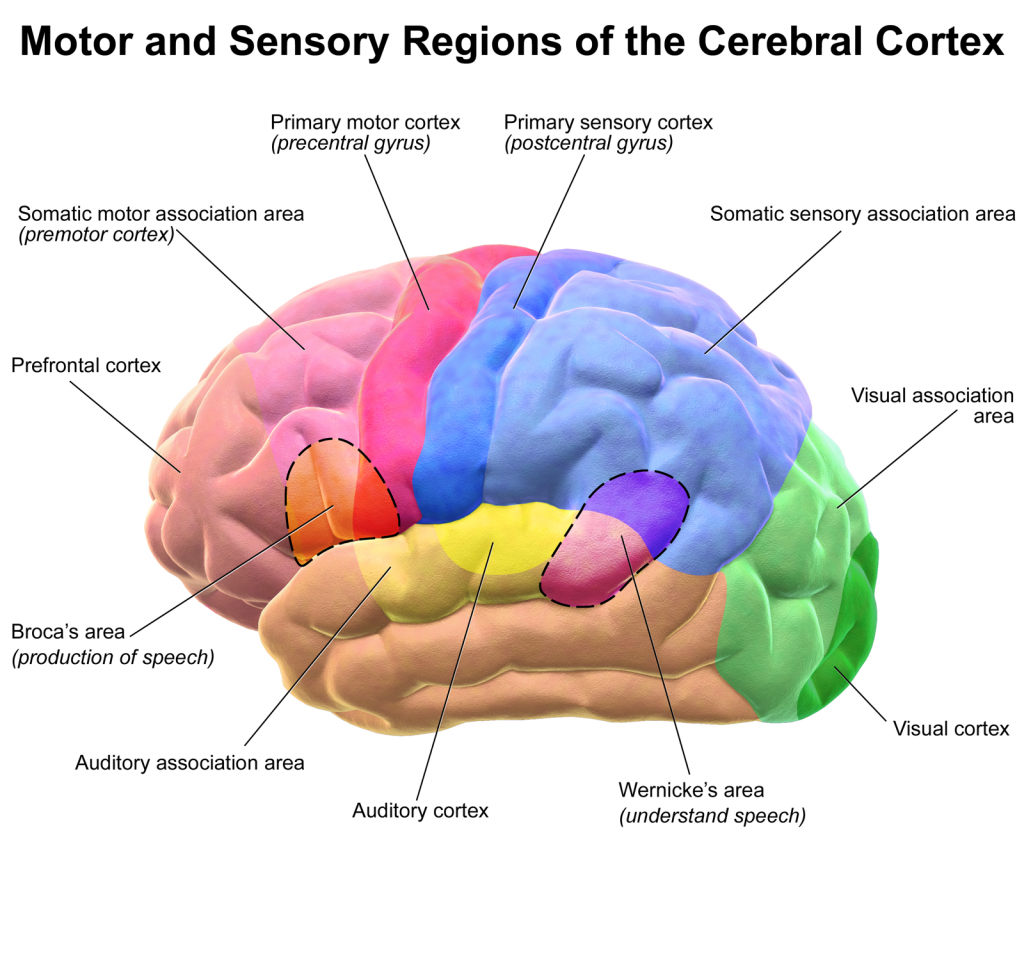
Anatomy
Central Nervous System
Which of the following best describes the blood supply to the temporal lobe:
Answer:
The blood supply to the temporal lobe is from the posterior cerebral artery (medial part of the lobe) and the middle cerebral artery (lateral part of the lobe).Temporal Lobe
Anatomy / Central Nervous System
Last Updated: 11th April 2019
The temporal lobe extends from the temporal pole to the occipital lobe and lies inferior to the frontal and parietal lobes, from which it is separated by the lateral sulcus.

Lobes of the Brain. (Image by BruceBlaus (Own work) [CC BY 3.0 , via Wikimedia Commons)
Cortical Areas
Table: Cortical Areas of the Temporal Lobe
| Area | Function | Lesion |
|---|---|---|
| Wernicke’s speech area | Language comprehension | Receptive dysphasia |
| Primary auditory cortex and auditory association area | Perception and recognition of auditory stimuli | Partial cortical deafness, auditory agnosia |
| Limbic association cortex | Memory, learning, emotion | Memory impairment, increased aggression, difficulty recognising faces/objects |
| Optic radiation | Carries visual information to primary visual cortex | Contralateral homonymous superior quadrantanopia |
- The Wernicke's speech area (in the dominant hemisphere only) is responsible for comprehension of written and spoken language. It is connected to the Broca's speech area by the arcuate fasciculus.
- The primary auditory cortex and auditory association area are important for perception and recognition of auditory stimuli.
- The limbic association cortex is important in memory, learning and emotion.
- The fibres of the lower part of the optic radiation (serving the upper quadrant of the contralateral visual field) pass through the temporal lobe.

Motor and Sensory Regions of the Cerebral Cortex. (Image by Blausen.com staff. “Blausen gallery 2014, via Wikimedia Commons)
Blood Supply
The blood supply to the temporal lobe is from the posterior cerebral artery (medial part of the lobe) and the middle cerebral artery (lateral part of the lobe).
![By derivative work: Frank Gaillard (talk) Brain_stem_normal_human.svg: Patrick J. Lynch, medical illustrator (Brain_stem_normal_human.svg) [GFDL 1.3 (www.gnu.org/licenses/fdl-1.3.html), GFDL 1.3 (www.gnu.org/licenses/fdl-1.3.html), CC BY-SA 3.0 (http://creativecommons.org/licenses/by-sa/3.0) or CC BY 2.5 (http://creativecommons.org/licenses/by/2.5)], via Wikimedia Commons](https://primary-cdn.frcemsuccess.com/wp-content/uploads/2017/01/Cerebral-Vascular-Territories-1-1.jpg)
Cerebral Blood Supply. (Image by derivative work: Frank Gaillard (talk) Brain_stem_normal_human.svg: Patrick J. Lynch, medical illustrator (Brain_stem_normal_human.svg) [GFDL 1.3 (www.gnu.org/licenses/fdl-1.3.html), via Wikimedia Commons)
Clinical Implications
Damage to the temporal lobe may result in:
- Receptive dysphasia - damage to the Wernicke's speech area
- Visual field defect (contralateral homonymous superior quadrantanopia) - damage to the optic radiation
- Memory impairment - damage to the limbic system
- Emotional and behavioural disturbances - damage to the limbic system
- Auditory agnosia - damage to the primary auditory cortex or auditory association areas
- Partial cortical deafness (due to bilateral cochlear representation) - damage to the primary auditory cortex

Cortical Language Areas. (Image by Peter Hagoort [CC BY 3.0 , via Wikimedia Commons)
Report A Problem
Is there something wrong with this question? Let us know and we’ll fix it as soon as possible.
Loading Form...
- Biochemistry
- Blood Gases
- Haematology
| Biochemistry | Normal Value |
|---|---|
| Sodium | 135 – 145 mmol/l |
| Potassium | 3.0 – 4.5 mmol/l |
| Urea | 2.5 – 7.5 mmol/l |
| Glucose | 3.5 – 5.0 mmol/l |
| Creatinine | 35 – 135 μmol/l |
| Alanine Aminotransferase (ALT) | 5 – 35 U/l |
| Gamma-glutamyl Transferase (GGT) | < 65 U/l |
| Alkaline Phosphatase (ALP) | 30 – 135 U/l |
| Aspartate Aminotransferase (AST) | < 40 U/l |
| Total Protein | 60 – 80 g/l |
| Albumin | 35 – 50 g/l |
| Globulin | 2.4 – 3.5 g/dl |
| Amylase | < 70 U/l |
| Total Bilirubin | 3 – 17 μmol/l |
| Calcium | 2.1 – 2.5 mmol/l |
| Chloride | 95 – 105 mmol/l |
| Phosphate | 0.8 – 1.4 mmol/l |
| Haematology | Normal Value |
|---|---|
| Haemoglobin | 11.5 – 16.6 g/dl |
| White Blood Cells | 4.0 – 11.0 x 109/l |
| Platelets | 150 – 450 x 109/l |
| MCV | 80 – 96 fl |
| MCHC | 32 – 36 g/dl |
| Neutrophils | 2.0 – 7.5 x 109/l |
| Lymphocytes | 1.5 – 4.0 x 109/l |
| Monocytes | 0.3 – 1.0 x 109/l |
| Eosinophils | 0.1 – 0.5 x 109/l |
| Basophils | < 0.2 x 109/l |
| Reticulocytes | < 2% |
| Haematocrit | 0.35 – 0.49 |
| Red Cell Distribution Width | 11 – 15% |
| Blood Gases | Normal Value |
|---|---|
| pH | 7.35 – 7.45 |
| pO2 | 11 – 14 kPa |
| pCO2 | 4.5 – 6.0 kPa |
| Base Excess | -2 – +2 mmol/l |
| Bicarbonate | 24 – 30 mmol/l |
| Lactate | < 2 mmol/l |

